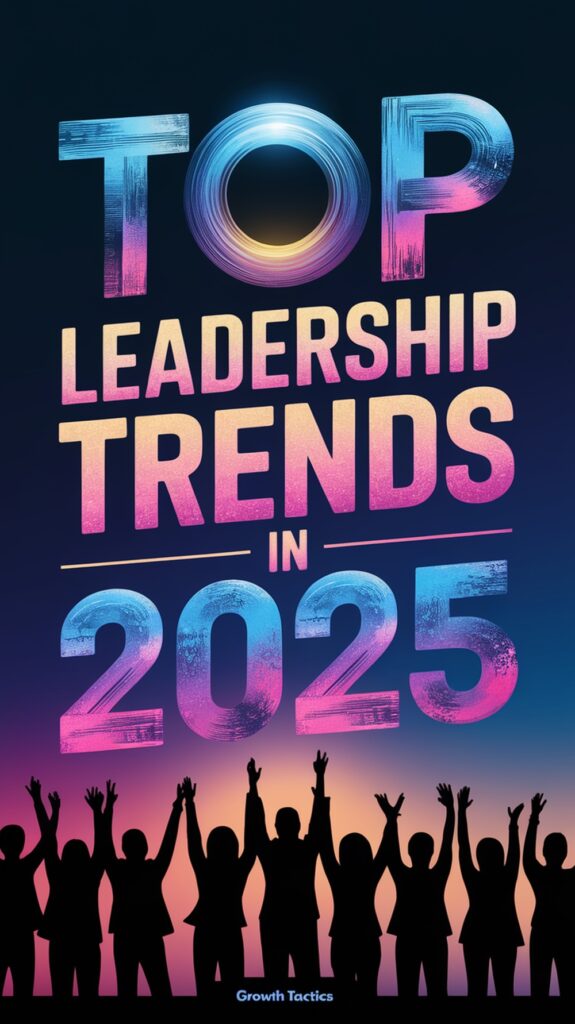The workplace is changing, and no one knows this better than business leaders. In order to keep up and stay the most effective, you must be able to learn and adapt. In this article, we are going to discuss the top leadership trends in 2025. Utilizing these leadership trends will get you the results you are looking for in your business.
Jump To Section
Goal-setting and accountability
Your employees will be more motivated and productive if you have a system for setting goals that include:
Setting realistic, challenging, and attainable goals. Goals are important because they give people something to strive for. But they must be attainable or else people won’t see the point in trying. The best way to ensure this is by making sure that each employee’s goal-setting process includes multiple checkpoints along the way. For example, quarterly reviews or monthly check-ins so that progress can be recognized and rewarded. Achieving these milestones should also provide employees with an opportunity to reevaluate their goals.
Holding people accountable for reaching their goals (and taking responsibility when they don’t). One challenge with goal-setting systems is ensuring people take ownership over their actions and outcomes. Otherwise, there isn’t as much incentive for success. When setting up your own goal system, make sure each employee knows precisely what his or her tasks are. Leave no room open for misinterpretation or excuses when things go wrong.
See Related: How to Write SMART Goals (Definition and Examples)

Learning to Be Adaptable and Managing Change
A key leadership trait in the 21st century is being adaptable. As the world becomes more complex, companies and leaders must be able to quickly adjust to new challenges and opportunities as they arise. Being adaptable means that you can look at your current operations with a critical eye. Identify areas for improvement and implement changes that will benefit your organization over time.
Being adaptable doesn’t mean overhauling everything about how your company does things. It just means taking stock of what’s working well. What could be improved, and coming up with ways to address both situations. For example, if one of your products isn’t selling well enough. But there are plenty of people who are interested in it but don’t know how/where to purchase it from you. Then perhaps offering free shipping on all orders above $50 will increase sales volume while also getting more customers through the door.
Investing in Employee Well-Being
Investing in employee well-being is a key trend for leaders. Employee well-being encompasses the physical, emotional, and mental health of employees, as well as their energy levels and productivity. As leaders, if we take care of our people, they will typically take care of the job.
Leaders can measure employee wellness by checking in on them. Set aside time each day to talk to your employees. You don’t have to solve all their problems for them but just being there and listening shows them you care. Which goes a long way.
You can also set up programs that provide resources or services that support the physical, emotional, or mental well-being of employees. These include physical fitness centers on-site at work, mindfulness training classes, yoga sessions, massage therapy services, etc. Provide them with benefits for staying healthy. Like paid time off for medical appointments, subsidized gym memberships, or fitness trackers/wearable devices. All of these encourage people to stay active and healthy. Without having to pay out-of-pocket costs incurred by their healthcare provider’s office visit fees.
What are the benefits? Employees who practice good health habits are less likely to miss work due to illness or injury. Which reduces overall absenteeism rates at companies where this is happening often (like Amazon). Productivity and focus are also increased due to employees being happier and healthier.
See Related: 21 Employee Recognition Ideas To Show Your Employees You Care

Fostering Teamwork
If you are a leader, team building is one of the most important things that you can do. This will increase the success of your business overall. Teamwork is the ability to gather and coordinate resources in order to achieve a common goal. This means that teamwork involves more than just getting along with each other. It requires everyone on the team to help one another with their respective tasks. So that they all contribute equally to whatever outcome is needed by management.
It’s easy enough for anyone who has worked with others before to understand what teamwork looks like when it happens naturally. But it’s not always easy for managers or leaders to foster this kind of positive environment. Where employees feel valued and able to contribute at their best level of performance.
Using Technology to Automate and Streamline Processes
Technology is one of the most effective tools available for leaders looking to enhance efficiency and focus on what truly matters. If used purposefully, it can transform how you approach decision-making, time management, and communication with your team.
For example, project management tools like Trello or Asana help leaders organize tasks and delegate responsibilities clearly. These platforms allow you to track progress in real-time, creating transparency across your team while freeing up time for strategic thinking.
Tools like Slack or Microsoft Teams streamline communication. Instead of wasting time sorting through endless emails, you can centralize conversations, share files, and hold quick virtual meetings. All in one place. This keeps you and your team focused, even when juggling multiple priorities.
For reporting and data analysis, platforms like Tableau and Google Analytics make generating detailed and accurate reports simple. These tools take the guesswork out of understanding performance metrics and help you stay informed on key trends.
Automation software like Zapier or Power Automate can save hours by connecting systems together and automating repetitive tasks like data entry or email follow-ups. This allows you and your employees to shift energy toward higher-impact work.
Finally, leadership is about vision and alignment. You can use tools like Miro or Lucidchart to map out strategies and brainstorm ideas visually, helping teams stay inspired and connected to the bigger picture.
Remember, technology is there to serve your purpose, not replace it. Take the time to explore tools that fit your leadership style and your team’s needs. When you invest in the right systems, you’re investing in people and better outcomes.
See Related: Team Management Apps List to Boost Your Teams Productivity and Effectivity
Mentoring programs for fast-trackers
Although mentoring programs are useful for everyone in the company, they can be particularly helpful for fast-trackers. Fast-trackers often don’t have the opportunity to work directly with senior leaders, so they can benefit from mentorship opportunities. Mentoring programs provide a forum for mentees to learn about leadership skills and time management from more seasoned colleagues. Providing this mentorship can benefit the whole company, growing future leaders.
Team-based compensation strategies
If you’re looking to build a company that gets results, and if you want your people to be happy and motivated, team-based compensation strategies are a great option.
Team-based compensation is a strategy that fairly rewards each member of the team who’s contributed toward a goal by sharing bonuses or equity among all members of the team. This builds trust among colleagues and motivates them to keep doing their best work. People start working toward the good of the team instead of just their own needs. It also allows managers to reward individual performance without having to micromanage every detail.
The benefits are numerous with team-based compensation. When everyone on your team feels like they’re winning, it creates an overall sense of happiness throughout your organization and that’s something every employer wants! Not only does this improve productivity and morale at work, but it also helps boost employee retention rates as well. This means less turnover for you!
Putting an Emphasis on Developing Others
One of the top leadership trends is the putting of an emphasis on developing others. This is more than just a responsibility for leaders, but is also a key to the success of the organization and its leaders. Employees are a company’s most valuable resource and need to be treated that way.
Leaders who take time to develop their people are more likely to have successful teams, which results in better productivity and higher quality work. When people feel valued and recognized for their contributions, they are motivated to do even better work. This creates a positive cycle that raises the bar across your entire organization and that can mean big things for your bottom line!
See Related: 15 Free Personal and Professional Development Resources

Extensive networking opportunities
Networking is a valuable tool, and it’s one that many people don’t use to its fullest potential. A good network can help you find new opportunities, build relationships with mentors and sponsors, find new clients and customers, find partners or investors for your business, and even recruit talent for your team. These are all things that will help you grow in your career and networking is one of the best ways to make them happen!
Emphasis on corporate social responsibility
Corporate social responsibility (CSR) is the commitment a business makes to be responsible and accountable for its actions and impacts on society, whether positive or negative.
Why CSR matters: By taking an active role in their communities, businesses can be more than just customers; they can also become valuable partners in change and innovation. Having a positive image in the community can help make things like recruiting talent and networking easier for companies.
How it’s done: Companies can integrate CSR initiatives into their workplace to help employees feel more connected to their community, provide an opportunity for them to learn about how their work affects people outside of the office walls, and ultimately create greater brand loyalty among consumers who want companies with values similar to their own. To measure success, consider how many people you’ve reached with your efforts and how much money you’ve raised or donated.
Use of strategy coaches and consultants
You may be considering hiring a strategy coach or consultant to help you improve your leadership skills. This is a wise decision and one that will ultimately result in positive changes for both yourself and your team. But what exactly are the benefits of this type of coaching?
What can a strategy coach or consultant do for you, your company, and your leadership? How does having one on board benefit everyone involved?
A good strategy coach will help you develop personal skills such as goal setting and time management so that they work more effectively within their own personal lives as well as at work. They’ll also help build stronger relationships with coworkers by providing advice about how to communicate better with people from all walks of life (including employees). Having someone like this around can make it easier for everyone involved because they’re helping them understand each other better by improving communication between teammates instead of just focusing on what needs to be done next.
See Related: Find An Online Life Coach To Reach New Heights Of Personal Growth
Leading Multiple Generations
As a leader, your job is to lead multiple generations. The next decade will see a massive influx of retiring Baby Boomers and Gen Xers, leaving an increasingly large leadership gap that must be filled by incoming Gen Z and Millennial workers. In turn, these younger employees will have different expectations for their jobs than the older employees who currently occupy those positions.
Leading multiple generations requires great flexibility on your part as well as the ability to motivate everyone in your organization regardless of age group or background. To help you navigate this new terrain, here are some tips on how to manage each generation at work:
- Baby Boomers (born between 1946-1964) grew up during wartime and expect prompt feedback from managers. They’re known for their loyalty but can also be stubborn if they feel slighted in any way. They like working with people their own age and may resent younger workers who try to take over their roles.
- Generation X (born between 1965-1980) grew up during civil rights protests and want flexible schedules so they can balance family life with career goals. These independent thinkers aren’t afraid of change but do need someone else’s guidance when making big decisions about work-life. They value teamwork above all else.
- Millennials (born between 1981-1996) are often seen as a generation that is spoiled and entitled. They’ve grown up with technology and have a sense of entitlement that many older generations don’t understand. But, millennials also bring a lot to the table. They are digital natives who are adaptable and quick to learn. The key to managing millennials in your workplace is understanding what motivates them and how they can be engaged.
Promotion of diverse candidates for all positions
Diversity is important in the workplace because it allows for better problem-solving, higher quality products and services, and more effective communication.
When you have a diverse group of people, you have more perspectives on a problem or issue. This allows for better solutions and ideas to be discovered. A diverse group also helps create a culture of inclusion within the company that can help to foster innovation and creativity.
In addition, when you have a diverse group of people working together, they’re able to communicate with each other more effectively than if there were only one type of person in the room. This helps to ensure that everyone feels heard and understood by their colleagues and that they understand each other as well!
See Related: Why is Diversity in the Workplace Important? 8 Advantages
Development of work-life balance initiatives
A key trend in leadership is the development of work-life balance initiatives. In order to attract and retain talented workers, companies are creating more flexible work arrangements that allow employees to pursue their personal goals as well as those related to their careers. This can include flexible hours, locations for working remotely, or schedules that allow for time off during peak times (e.g., summer vacation). Companies that make an effort at this will be able to attract top talent while retaining existing employees who may be considering other positions or opportunities elsewhere.
Utilizing Remote Teams and Managing Telework Employees
Remote teams are a growing trend and for good reason. They can be more productive than co-located teams, more cost-effective than co-located teams, and more innovative than co-located teams. Remote employees have been shown to have higher retention rates than their onsite counterparts because they’re happier with the flexibility that telework offers them. This means you’ll find it easier to recruit and retain top talent as well as save money on office space costs.
See Related: Remote Leadership: How to Lead When Away from the Office
Dealing With High Turnover
The number one concern for leaders is retaining employees. It’s been that way for a little while now, and it shows no signs of abating anytime soon.
Here’s how to deal with a high turnover:
- Identify the causes of high turnover: Is it a lack of clarity in your company’s vision? Do you have a toxic culture in place where employees feel disrespected or taken advantage of? Do you not offer sufficient training or development opportunities to keep your employees engaged? Are they just fed up with working long hours, or do they have families that need their time and attention?
- Create an employee turnover plan: Once you’ve identified what’s causing a high turnover at your organization, create a plan that addresses these issues head-on. For example, if your process for hiring new full-time staff isn’t clear enough for candidates and new hires alike, create a clear job description template on Workable so everyone knows exactly what they’re getting into before accepting any offer letter from you. Can’t find enough time in the day to train each employee on all aspects of their jobs? Use online training platforms like Udemy to teach employees how best to use processes within their departments; this will save valuable time while providing excellent results (and keep them from quitting).
All of these leadership trends will help companies get better results from their employees.
These are just some of the trends that we’ll be seeing. It’s important to get ahead of these trends and figure out which ones work best for your team and company. Some of them, like “employees will have more money and time to spend outside of work,” are not new ideas at all; they’ve been around for years, but they’re still important to consider.
Others, like “more companies will offer telecommuting options” or “more companies will offer flexible hours,” are new ideas that may have an impact on your business if you take action now. And finally, some things aren’t new at all like employee engagement being important but if you haven’t already started focusing on it, then maybe it’s time to start!
Conclusion
I hope you have found this article informative and helpful. As we have discussed, there are many trends that will shape the way business is run in 2025.
Did you enjoy this article on the top leadership trends? Please don’t forget to share below.








